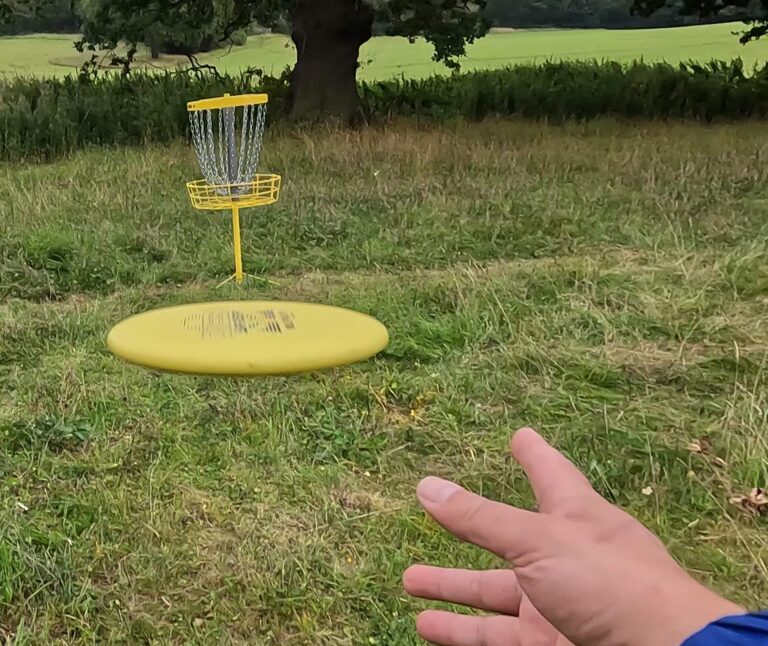You can throw drives that hum like a tuning fork, then miss from ten feet and feel the round slip away. Here are disc golf putting tips that cut the wobble, tidy your routine, and nudge the chains in your favour. If you want fewer three putts and more tap-in birdies, you are in the right place.
Problem. Missed putts pile up fast, and confidence shrinks with every rim out. Agitation. The harder you try, the tighter your grip, the shakier your release, the louder the inner critic. Solution. Build a simple, repeatable process that works under pressure, then practise it smartly with drills that target real weaknesses. Let’s make the basket feel larger and your scorecard lighter.
Why Putting Matters for Lower Scores
A great drive sets the stage. A clean putt takes the bow. Most strokes are won or lost inside the putting circle, so small improvements pay back every round. Choose a target link, keep your eyes on it, and commit. You will miss less, and two putts will start to look boring in the best way.
Disc Golf Putting Tips for a Rock Solid Foundation
Disc Golf Putting Grip
Use a grip that feels secure without strangling the rim. Fan grip for touch, stack grip for pop. The goal is a clean, nose-neutral release. If the putter wobbles, loosen the last two fingers slightly. If it slips, add a fraction more pressure on the pad of the index finger.
Disc Golf Putting Stance
Square or staggered both work. Square gives balance, stagger adds forward momentum. Keep your weight centred, knees soft, chest tall. On uneven ground, shorten your stride and lower your centre to stay stable.
Pre Putt Routine
Build a short, repeatable checklist. One breath. One aim. One smooth stroke. That is your putting routine for disc golf. It calms nerves and creates reliable timing, so your body performs even when your brain is busy.
Start Close to Build Trust
Begin at 3 to 10 feet, make lots, then step back in small jumps. Confidence is a skill. A string of makes is better training than flinging from circles edge and hoping for the best.
Pick the Right Tool
Choose a stable putter that fits your hand. If putts sail high, try a lower glide mould. If they drop early, pick something with a touch more glide. Keep one putter for putting only, so feel and release stay consistent.
Disc Golf Putting Techniques You Should Practise
Two main styles dominate, and both can win.
- Spin putting disc golf players use for laser lines and windy days. The wrist adds rotation, the flight holds straighter.
- Push putting disc golf players favour for clean, floaty lines. Less wrist, more legs and extension. Great for distance control.
Mix in these drills to sharpen your edge.
- Ladder drill Set cones at 10, 15, 20, 25, 30 feet. Make 5 at each before moving on. Teaches distance control under fatigue.
- Obstacle gate Place two mini discs as a gate. Putt through with a flat release. Add a slight hyzer release when the wind pushes right.
- Pressure putts Put a score on it. Miss two in a row and you restart the set. Gamifying practice builds tournament composure.
- Form filming Record from the side and front. Look for a smooth weight shift, straight elbow path, and balanced finish to tidy your disc golf putting form.
Advanced Putting Strategies That Pay Off
- Wind reading for disc golf putting Check leaves, flags, and your shirt hem. Headwind, aim a touch lower and flatter. Tailwind, give it more height. Crosswind, start the line upwind and add a gentle hyzer release if needed.
- Use the basket Aim at inside chains on short hyzers, outside chains for banked entries. Play safe on roll away slopes, soft nose, centre chains.
- Terrain reading On uneven ground, shorten your step and plant firmly. Uphill needs extra pop. Downhill needs soft hands and a lower apex.
- Disc golf putting mental game Count your routine, not your fears. One breath in, one aim point, one follow through. The brain loves rituals, so give it one.
- Advanced putting strategies Build a simple game plan. Inside 20 feet, be aggressive. Outside circles edge, lay up to a stress free comebacker if hazards lurk.
Common Mistakes and Quick Fixes
- Grip too tight White knuckles cause early releases. Relax the last two fingers and let the index pad guide the rim.
- Eyes leave target Stare at one link until the disc hits chains. Looking early sends the putter wide.
- Flat feet You need a gentle weight shift. From back foot to front, then freeze the pose. That makes clean energy without a jab.
- Wild nose angle Nose up stalls. Nose down dives. Keep the wrist flat with the forearm and your stable putter will behave.
- No plan in wind Decide the line before you putt. Commit to the read you made, do not adjust mid stroke.
Practical Notes for Course Day
- Warm up smart Ten makes from 10 feet, ten from 20, five from 25. Finish with the range you fear most to normalise it.
- Pick a tiny target A single chain link beats the whole basket. Small aim points sharpen focus.
- Two stage long putts On stretches over 50 feet, play to a tap in first. Then clean up. You will cut big numbers without dulling aggression.
- Know the rules Step putts are fine outside the putting circle. Inside it, keep your balance until the disc sticks or misses.
Frequently Asked Putting Questions
Here are quick answers to the stuff players ask most, from drills to wind to nerves. Keep reading, then put the ideas to work in practice.
There is no magic number. Aim for focused quality over volume. Start with 20–30 makes from mixed distances, review your form, then add sets as consistency improves. Track makes and misses so practice becomes progress, not guesswork.
Usually yes, but comfort wins. Test both hands for a week of practice. Choose the one that gives a smoother release and steadier aim. Switching hands mid season is rare unless injury forces it.
Replace it when wear changes the feel or flight. Rim nicks that snag on release or a flight that now fades or turns differently are clear signs. Many players keep a fresh putting putter and a seasoned throwing putter.
Rushing Follow your routine.
Gripping too tight Use firm, not white knuckle pressure.
Eyes leaving target Hold the aim link to the hit.
Skipping practice Short, regular sessions beat marathons.
Gates, pocket baskets, and chalk lines can help for drills. Use them to learn a feel, then wean off so your motion stands up on any course, in any wind.
Circle 1 is 10 metres from the basket. Inside it you must maintain balance behind your lie until the disc comes to rest. Outside, step putts and jump putts are allowed under the rules.
Neither is universally better. Spin putts hold lines in wind and on longer looks. Push putts float straight with less wrist. Try both, then build the style that gives you the highest make rate inside 30 feet.
The best grip is the one that releases cleanly. Most players use a fan or modified fan grip. Test pressure on the index pad and middle finger until wobble disappears and the nose angle stays neutral.
Read the wind with leaves and flags. Into a headwind, aim flatter and a touch lower. With a tailwind, give more height. Crosswinds call for aiming upwind and using gentle hyzer to fight the push.
Keep it short. One breath, set the feet, pick a link, one pump, release. Repeat it for every putt in practice so it holds up during pressure putts in competition.
Bonus tip Break long attempts into phases. Land it inside the circle, then trust your pre putt routine for the clean finish. Small wins build big confidence.
Have fun, hit chains, and keep the process tidy. Your scorecard will thank you.






